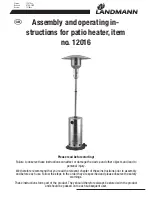
Features and technical data
20
1
1.5
ELECTRONIC BOARD
The appliance's electrical panel contains the GEN10 mi-
croprocessor electronic board, which controls the appli-
ance and displays data, messages and operating codes.
The appliance is monitored and programmed by in-
teracting with the display and selection keys (Figure
p. 20).
Figure 1.13
GEN10 board display
1.6
OPERATION MODE
The Next-G gas unit heater has the possibility of operating
in two modes, which can be selected via parameter P42
(Paragraph 5.4
p. 48):
▶
with the OCDS015 remote control (or a generic
Modbus controller)
▶
without remote control
There are two service requests for both modes:
▶
ventilation
▶
heating
The features available with each operating mode are de-
tailed below.
The Next-G gas unit heater, thanks to the presence of the
supplied room probe, modulates the heat output con-
tinuously, following the setpoint set in parameter P53
(Paragraph 5.4
p. 48).
If you do not wish to use the supplied room probe, it will
be possible to manage the gas unit heater operation on
two power levels by opening or closing the "VENT." con-
tact (the "HEAT." contact must be closed by a suitable de-
vice to activate the heating request, Table 1.1
p. 20):
▶
contact "VENT." closed: maximum power operation
▶
contact "VENT." open: minimum power operation
1.6.1
With the OCDS015 remote control
With the OCDS015 remote control, or a generic Modbus
controller, to activate the heating or ventilation service
it is necessary that the service is requested via Modbus
(for a generic Modbus controller refer to the Modbus map
document for the specific FW version of the GEN10 board)
and that in addition the corresponding contact service
request input is closed (Paragraph 4.4.8.1
p. 40).
If not managed, the contact service request inputs
must be jumpered accordingly.
The document describing the mapping and
meaning of the Modbus registers implemented
on the GEN10 board is available on-demand from
Robur technical service.
The 0-10 V input is never used in this configuration.
Loss of communication with the remote control
or generic Modbus controller results in deacti-
vation of the service request and shutdown of
the appliance.
The supported service request types are:
▶
standby
▶
ventilation
▶
fixed power heating (3 power levels), with the remote
control providing the setpoint and current room tem-
perature
▶
fixed power heating (3 power levels), with the remote
control providing the setpoint and room temperature
measured by the appliance using the supplied room
probe
▶
modulating heating, with the remote control provid-
ing the setpoint and current room temperature
▶
modulating heating, with the remote control provid-
ing the setpoint and room temperature measured by
the appliance using the supplied room probe
▶
modulating heating, with the remote control provid-
ing the required power level as a percentage of maxi-
mum power
1.6.2
Without remote control
Without the remote control, or a generic Modbus control-
ler, the service request is made exclusively via the appro-
priate contact request inputs (Paragraph 4.4.8.1
p. 40).
Depending on the active inputs, the functions described
in the following Table 1.1
p. 20 are obtained.
Table 1.1
Functions available depending on the status of the
contact inputs
“VENT.” input
“HEAT.” input
Features
open
open
off
closed
open
ventilation
open
closed
heating at power level 1 or
modulating
closed
closed
heating at power level 3 or
modulating
More in detail, thanks to the presence of the supplied
room probe, when the "HEAT." contact is closed, the gas
unit heater will operate in heating mode in modulation,
regardless of the status of the "VENT." contact.
To achieve operation on two power levels it is necessary
to set parameter P45 to value 0 (Paragraph 5.4
and at that point it will be possible to manage the two
power levels either through the contact request inputs,
as described above, or through one of the commands
that allow automated management of the power levels
















































